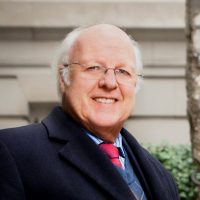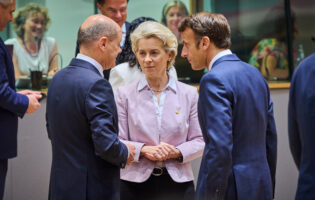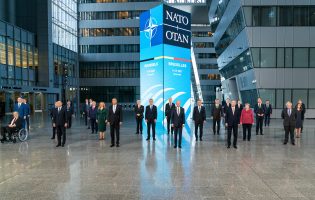
Facing the Future: Germany and the U.S. in a Transforming World

Jackson Janes
President Emeritus of AGI
Jackson Janes is the President Emeritus of the American-German Institute at the Johns Hopkins University in Washington, DC, where he has been affiliated since 1989.
Dr. Janes has been engaged in German-American affairs in numerous capacities over many years. He has studied and taught in German universities in Freiburg, Giessen and Tübingen. He was the Director of the German-American Institute in Tübingen (1977-1980) and then directed the European office of The German Marshall Fund of the United States in Bonn (1980-1985). Before joining AICGS, he served as Director of Program Development at the University Center for International Studies at the University of Pittsburgh (1986-1988). He was also Chair of the German Speaking Areas in Europe Program at the Foreign Service Institute in Washington, DC, from 1999-2000 and is Honorary President of the International Association for the Study of German Politics .
Dr. Janes is a member of the Council on Foreign Relations, the International Institute for Strategic Studies, the Atlantic Council of the United States, and American Purpose. He serves on the advisory boards of the Berlin office of the American Jewish Committee, and the Beirat der Zeitschrift für Außen- und Sicherheitspolitik (ZfAS). He serves on the Selection Committee for the Bundeskanzler Fellowships for the Alexander von Humboldt Foundation.
Dr. Janes has lectured throughout Europe and the United States and has published extensively on issues dealing with Germany, German-American relations, and transatlantic affairs. In addition to regular commentary given to European and American news radio, he has appeared on CBS, CNN, C-SPAN, PBS, CBC, and is a frequent commentator on German television. Dr. Janes is listed in Who’s Who in America and Who’s Who in Education.
In 2005, Dr. Janes was awarded the Officer’s Cross of the Order of Merit of the Federal Republic of Germany, Germany’s highest civilian award.
Education:
Ph.D., International Relations, Claremont Graduate School, Claremont, California
M.A., Divinity School, University of Chicago
B.A., Sociology, Colgate University
Expertise:
Transatlantic relations, German-American relations, domestic German politics, German-EU relations, transatlantic affairs.
__
Those who remember the heady days of 1989 in Europe will recall a breathtakingly fast pace of change. The chain of events in Eastern Europe seemed like a volcanic eruption of citizens and governments—an eruption that would change the contours of the continent in ways many had hoped for, but few expected in their lifetimes. In retrospect, it was in large measure set in motion by ordinary citizens who changed the course of history. The ripples of those days are still being felt today—a quarter of a century later.
For no country is the impact of 1989-1990 more fundamental—and transformative—than Germany, a country on the front line of the Cold War. Washington’s support of unification was a unique moment in German-American relations, a moment in which all the shared sacrifices of the past decades were rewarded on the steps of the Reichstag on October 3, 1990.
Pre-1990, Germany was the object of American foreign policy, with more military presence than in any other country in the world. Since 1990, Germany has become a subject of U.S. policy. But as a subject of U.S. foreign policy, Germany would be viewed as a “partner in leadership,” as expressed by President George H.W. Bush in 1989. Unified Germany was now needed to help with problems beyond its borders. Making that transition proved difficult for many Germans, both in terms of their perceptions of themselves—and of their global role.
Following that historic October day, the U.S. was quickly engaged in a war in Iraq; the following 25 years were anything but peaceful around the globe. In Europe, the end of the Cold War revealed both scars and open wounds that would lead to war in the Balkans. Conflicts in Africa and the continuing violence in the Middle East reminded us that the post-Cold War era was no less dangerous than before—a message that was delivered dramatically and tragically to the U.S. in 2001.
Like the Germans did a decade earlier, Americans have struggled since that September day with a transition of both the world and the American role within it, best described as a struggle to come to grips with changing constellations of power, influence, and resources.
The conditions that enabled Germany and the U.S. to manage the success of German unity in 1990 have changed. Germany is now embedded in a European Union of 28 nations bonded together not only by political and economic ties, but also by a shared mutual security commitment within NATO—the most successful alliance in history. That same Germany has become a pivotal power—a leader—in partnership within the EU and beyond. Twenty-first century Europe is a global player, engaged in every serious international organization, and with a stake in a world that has contributed to its own success.
The United States has also faced changes. In a triumphant mood after 1990 as the sole remaining superpower, a quarter-century later it has now emerged from its longest war in history and its deepest economic crisis in eight decades—and yet it remains the most powerful nation on the globe, with the largest economy. With that experience there has been a realization that the U.S. faces a world in which it needs to share burdens and share power, in which the web of interdependence has become more complicated and uncertain, and in which it needs to nurture common interests and goals with its partners.
The context in which Germany and the U.S. relate to each other, need each other, depend on each other in 2015 is not the same as it was in 1989. We share a commitment generally to the same political and economic systems underlying our democracies. We also share a commitment to the global goals of peace, growth, security, and stability for all nations and engage in those institutions and organizations that support those goals.
At the same time, Germany’s domestic priorities do not match those of the U.S. The narratives of best practices in dealing with the role of the government, the mix of social and market forces, and the responsibilities of the state run through different experiences and expectations. The perceptions of security and defense parameters differ along with the capabilities attached to them. The asymmetry of Germany’s singular dependence on the U.S. for its security has changed over the last quarter of a century. There are no longer half a million Americans deployed in Germany; Germany, together with its European partners, is faced with securing its own defense. That said, the Atlantic Alliance continues to depend on American resources and guarantees. A quick look around Europe—or anywhere else around the globe—reminds us that the need for hard power has not been lost in the twenty-first century.
In 2015, and for the foreseeable future, Germany, and along with it Europe, will continue to need a close partnership with the United States. The equations making up that partnership will be both old and new. They will be made up of economic interests in each other, shared opportunities to explore them across a wide range of innovations. They will be made up of mutual concerns about the wider world around us, be it the threats of terrorism, war, disease or dealing with the roots of instability, poverty or environmental dangers affecting us all. They will be made up of the need to share resources in responding to these challenges. Ultimately they will be based on a shared set of goals in achieving what our societies stand for. The values of freedom, justice, and security underline our political, economic an social systems. Because we are constantly learning how to achieve those values, especially when we fail, we can also learn from each other. We may not want to copy each other in all ways but we can certainly comprehend how to pursue common goals.
Twenty-five years after German unity, the world is different. It may not be safer. It still is beset by dangers and tensions at both the regional and global levels. But in looking at Germany within a European Union, one sees a world which not too long ago was seen as improbable. How many times was the phrase about the possibility German unification—“Not in my lifetime”—mentioned prior to 1989? How plausible was a European Union of 28 members committed to common set of goals (even when they argue constantly about how to achieve them)? And there are still more wishing to join that club.
The world in 2015 is more complicated, more uncertain, and perhaps more difficult to manage than it was 25 years ago. There are simply more players involved, competing and cooperating, in conflict or in consensus.
Germany and United States have an extraordinarily unique relationship. It has evolved over many decades—even centuries. Within one century it has experienced grand heights of friendship and dark depths of hostility. Over the past 70 years it has evolved into one of the most important bilateral partnerships for both countries. In that exceedingly complex and multi-level relationship there are many points of friction—and of friendship. That should be no surprise when such a wide and deep web of connections is involved. But as we look back on these past 25 years, there can be no doubt that Germans and Americans have come a long way with and for each other in common efforts and shared goals. Building on that foundation, there is still much to do.








